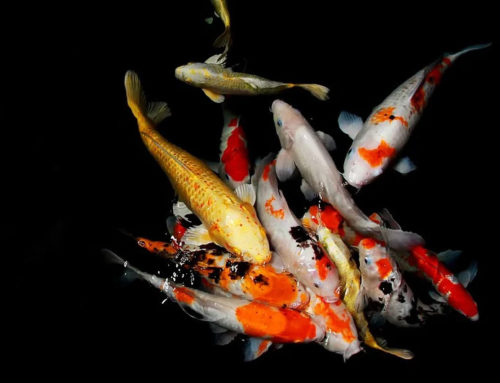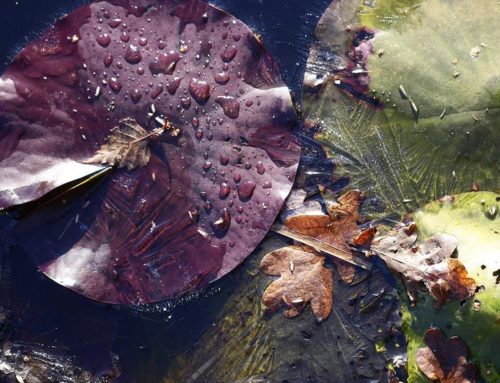Share this Image On Your Site
Please include attribution to Chuck’s Landscaping with this graphic.
What do Koi Fish Eat in the Wild?
Koi fish are the descendants of common carp. If released into the wild, koi that survive would eat meat and vegetation, just like common carp. They would eat:
- Algae
- Insects
- Worms
- Larvae
- Seeds
- Crustaceans
- Vegetation
Natural Behavior of Koi Fish
Even though they have been bred to take food from the surface, koi fish evolved to take advantage of a different strategy.
- In the wild, koi scoot along the floor, sifting through the mud to find food. This tends to make muddy ponds messy.
- Koi don’t have teeth. Instead, the two fleshy barbels hanging from their mouth help them feel out the bottom of ponds.
- Some koi have stopped cruising along the bottom and may instead try to hunt insects or other food on the surface.
What Should You Feed Your Koi Fish?
The majority of your koi’s diet should always be a store-bought food optimized for their health. You have many options:
Shape
- Flake: Best for the smallest koi and for their fry (baby koi).
- Pellet: Should be small enough for your koi to swallow whole.
- Bar: Best for the largest koi, though small koi will nibble it.
Dispersal
- Floating: The most fun to watch. Most koi will prefer to eat floating food.
- Sinking: Some koi find this a natural way to eat, but it is hard to monitor.
The Best Ingredients for Koi Fish Food
The nutritional value of the food is most important. The first ingredient should be fish-based and provides protein and most nutrients. The second is often a carbohydrate, which fish need too!
Primary Ingredient
- Fish meal
- Squid meal
- Whitefish
- Shrimp meal
- Anchovy meal
- Blood meal
- Herring meal
Secondary Ingredient
- Wheat germ
- Soybean meal
- Corn gluten
Nutritional Requirements for Koi Fish
You should also check over the label of your fish food to make sure it meets your koi’s nutritional requirements. Here’s what you should look for:
- 32-36 percent protein content. Koi won’t benefit from any extra protein, but higher protein isn’t bad.
- 3-9 percent fat content. Young fish need more protein to grow, while older fish need less unless sick.
- Low phosphorous. Excess phosphorous in your pond will reduce your water quality and promote algae.
- Koi fish also need small amounts of other nutrients including calcium, vitamins A, C, D, E, and K.
How to Feed Your Koi Fish
The biggest mistake new koi owners make is over-feeding their fish. Follow these instructions to avoid that and to keep your koi healthy.
- Sprinkle the food very slowly, for a maximum of five minutes.
- The koi should be eager to eat and not leave any food untouched.
- Feed your koi up to three times daily, or less in cold weather.
- Feed away from the skimmer, so it doesn’t pick up any food.
When to Feed Your Koi
You need to feed koi differently depending on the season, water temperature, and oxygen levels.
- In the spring, before and during mating season, your koi will crave food with extra protein.
- In the fall, they will prefer foods with more carbohydrates, to help them prepare for the winter.
- In the winter, koi hibernate at the bottom of their pond, so you won’t need to feed them at all.
- Stop feeding your koi at temperatures below 40° F and start again at temperatures above 40° F.
- Koi also need oxygen in order to digest their food, so you should monitor oxygen levels.
- Don’t feed your koi if your filter is broken; the oxygen will be too low. Get it fixed quickly.
- Install a waterfall to re-oxygenate the water if you are having trouble with oxygen levels.
Foods You Can Give Your Koi as a Treat
These are fun foods that koi often enjoy, but they are usually nutritionally poor, so you shouldn’t feed them more than two or three times a week.
Vegetables
- Garlic
- Broccoli
- Leak
- Endive
- Cauliflower
- Squash
- Lettuce
Fruit
- Melon
- Grapes
- Kiwi
- Strawberries
- Mandarins
- Orange
Other treats
- Hard-boiled egg
- Whole wheat bread
- Oatmeal flakes
- Cooked rice
- Cooked pasta
- Cheerios
How to Feed Koi Treats from Your Kitchen
Each different kind of treat needs to be prepared differently so your koi don’t hurt themselves.
- Vegetables are too hard for koi to nibble, so cut them up into pieces at least as small as your koi’s pellets.
- Fruits are soft enough for the koi to nibble, so some people cut them into slices and let the koi bite them.
- Grains are very fattening and should be fed the least. But, Cheerios can help an underweight koi gain weight.
- Pasta and rice need to be cooked, without salt, before koi eat them, or they will expand in the koi’s stomach.
Store Bought Koi Fish Treats
Some of the treats you purchase from the pet supplier are nutritious and can be fed more often than bread or other homemade treats. Your options include:
- Silkworm pupae
- Bloodworms
- Tubifex worms
- Earthworms
- Black mosquito larvae
- Wax moth larvae
- Tadpoles
- Shrimp
- Clams
- Duckweed
- Hyacinths
Foods to Avoid Feeding to Koi Fish
Though koi are flexible fish, there are a select few foods you should avoid feeding them, including:
- Fish you caught
- Bugs you caught
- Peas
- Corn
- White bread
- Frogs
By: Chuck’s Landscaping
Sources:
- https://www.arkive.org/common-carp/cyprinus-carpio/#text=All
- https://support.aquascapeinc.com/hc/en-us/articles/201260604-How-often-or-how-much-should-I-feed-my-Koi-and-Pond-Fish-
- https://www.pondtrademag.com/beyond-koi-pellets-expanding-your-kois-diet-for-nutrition-and-fun/
- https://koistory.com/koi-fish-feeding/
- https://koistory.com/blog/koi-fish-treats-what-to-feed-koi-and-what-to-avoid
- https://support.aquascapeinc.com/hc/en-us/articles/201260604-How-often-or-how-much-should-I-feed-my-Koi-and-Pond-Fish-
- https://www.petsmart.com/learning-center/fish-care/koi-care-guide/A0017.html



